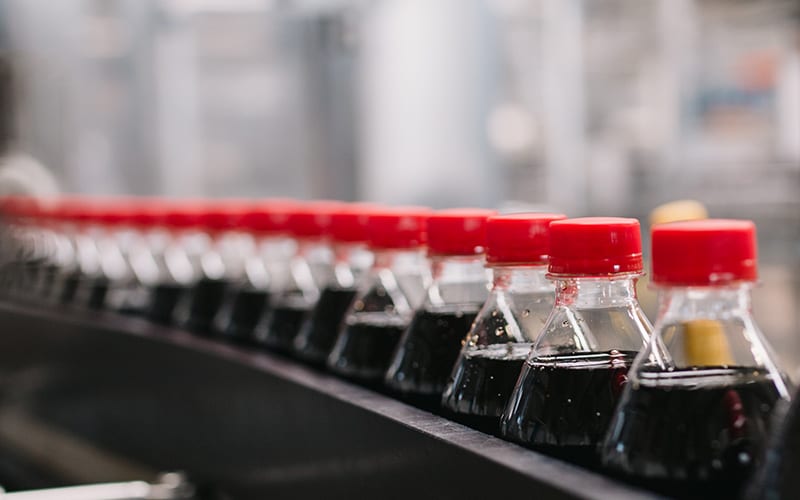Insights
- There are two big problems that retailers, brands, and logistics companies face today.
- Cost pressure.
- Rapidly changing consumer behaviour
- Retailers, brands, and logistics companies face an uphill climb in the new normal.
- The key will be to be agile. Artificial Intelligence can help with agility, but it needs plenty of clear, clean data.
- Value networks can provide this data and hence visibility and intelligence. So, the power is going to shift to value networks.
- Companies that have data and ability to act on it quickly, will become the center of this network.
- Companies will have to invest in partnerships, and start rethinking their role in the ecosystem, even if it means partnering with competitors.
The perfect storm is brewing
There are two big problems that retailers, brands, and logistics companies face today.
One is cost pressure. Consumer goods companies are feeling the margin squeeze due to rising raw materials prices. The Raw Materials Price Index is 18% higher than it was last year, according to the World Bank’s Commodity Markets Outlook report.1
Supply chain issues are also disrupting retailers’ well laid-out plans. For example, the undersupply of shipping containers is hitting companies’ margins hard. The average price to ship a container from China to California has increased by a substantial 344% since the start of 2020.2
The present freight costs are hitting margins between 60 to 125 basis points.3
Labor shortages and rising labor costs are also pinching retailers’ pockets. There are 1 million unfilled retail jobs in the U.S., according to the U.S. Bureau of Labor Statistics. The cost to employ transportation and warehouse workers has increased by 2.5% from 2020.4 Cost pressures are reducing margins and forcing companies to increase prices.
The other issue is changing consumer behavior. People have embraced the convenience of online shopping and delivery or curbside pickups. Physical stores still make up the lion’s share of the retail business, but e-commerce boom has made noticeable inroads into the market. The e-commerce share of total retail sales in the U.S. is estimated to rise from 15% in 2021 to a significant 24% by 2025.5
E-commerce opens opportunities to understand the customer better through its data. However, the current online business model lacks the ability to draw maximum profits — fulfilment costs are too high, and margins are wafer-thin. Also, product returns are three to four times higher in online retail than for physical purchases, adversely impacting profits.
Two problems – cost pressure and changing consumer behaviour; solution – visibility, transparency, and intelligence.
Visibility, transparency, and intelligence can solve it all
A transparent retail environment along with intelligent systems can enable players to take quick actions.
Visibility on demand levels, inventory status, and transportation costs can certainly benefit pricing and marketing. This need for access to trustable data across the supply chain will significantly change the roles of companies in the ecosystem and the way they behave.
The change is already underway — retailers are becoming logistics providers, brands are selling directly to consumers, and logistics companies are acting as retailing platforms.
For example, Walmart’s logistics platform, Walmart GoLocal, provides last-mile delivery services to smaller retailers.6 British grocery retailer Ocado licenses its technology to grocery retailers for their omnichannel retail business.7 Retailers are changing/expanding their roles to respond to evolving consumer needs.
The power is shifting to the network
In the traditional setup, retailers were the main touchpoints for consumers. Brands produced goods and handed them to retailers to sell. And logistics providers handled the transfer of goods. (Figure 1).
Figure 1: In the traditional retail setup, the retailer was the point of contact for the consumer
Source: Infosys
Now, the consumer is in the middle, and brands, logistics providers, retailers, digital platforms, and others connect directly with each other and the consumer (Figure 2).
Figure 2: In the new setup, the consumer is at the center, in the network of brands, retailers, logistics providers
Source: Infosys
This network provides visibility and intelligence to predict, prepare, and manage adversities.
The network among brands, retailers, and logistics providers gives them access to the holistic data required to understand the demand, the location of demand, the location of goods, and the capability to deliver goods. This network structure holds the success mantra, as it is not just about grabbing the consumer’s attention to buy a product but also about delivering that product to the consumer as quickly and cheaply as possible.
Driving value from data
Historically, systems have presented data, and humans have made decisions. Today, the number of variables and related complexity have increased with procurement, supply chains, and consumers spreading globally, complicating decision-making.
The silver lining is that companies can access enormous data through their networks and use it for better decision-making. Artificial intelligence (AI) and machine learning (ML) can help analyze this data to provide real-time recommendations for scenario/contingency planning.
Amazon is probably the most apparent example of this platform approach. And then, there are others who are building this network by themselves. For example, Nike has transformed from a footwear manufacturer to a platform. It provides digital spaces for consumers to directly engage with the brand through digital shopping spaces, digital experiences, and fitness initiatives.
This enables Nike to understand consumer expectations and plan products accordingly.
Many are venturing into partnerships to expand beyond their core competencies to quickly respond to the changing environment. For example, Walmart has partnered with TikTok to create shopping features on the social media app and tap into the social media trend.
This partnership allows people to shop without leaving the social media platform, while Walmart’s warehouses and logistics ensure swift fulfillment.8 Costco, a major U.S. retailer, has partnered with Uber for same-day delivery in some parts of the United States.9
Physical retailing is transforming from product-based to service-based model
As the power to determine demand and fulfillment shifts to the network, the role of retail stores will also change. Retail will have to be embedded around experiences to attract customers. Stores are going to cross-sell services, not just products.
Many retailers are shrinking product display areas and using that space to offer services to boost footfalls. For example, a grocery store might offer fresh-cooked food service as an extension.
CVS, a leading network of neighborhood pharmacies in the U.S., is planning to transform its pharmacies into primary health care centers.10
During the pandemic, retail stores were converted to dark stores, where parts of stores were used as warehouses for digital orders. However, this is not viable in the long run, as the rental costs of these stores are too high to be spent for warehousing.
Now, retailers opt for smaller physical stores and set up multiple small nodes (warehouses) within cities to enable faster last-mile delivery. These warehouse hubs are being shared by multiple brands, sometimes competitors.
Value network data can turbo-charge advertising impact
Advertising plays a significant role in consumer industries. Earlier, brands were entirely funding advertising and broadcasting directly to consumers, but consumers had access to brands through retailers. Now, everyone from a brand like Unilever to a marketplace like Amazon to a delivery platform like DoorDash is advertising — through emails, social media, Google Ads, websites, mobile apps, and others.
Still, the real potential of advertising is unmapped. Most advertisers are targeting the same consumer from different directions. Highly personalized advertising is much needed (Figure 3). The targeting could be based on the consumer’s location and product availability, as well as the consumer’s browsing history.
Data-driven advertising is audience-focused and can replace expensive, wasteful broadcast advertising.
Suppose a consumer searched for a specific toy on a website, but the product went out of stock. A few days later, the network works out that the buyer is at a different location, which is close to its store that has the product available. The retailer sends a notification to the consumer with a 50% discount code, thus gaining a customer, who was maybe undecided before, and saving on the shipping cost. This is one of the many highly targeted scenarios that retailers will realize. Data harnessed through the retail network could lead to efficient and profitable business models.
Figure 3: Value network data turbo-charges advertising impact through hyper-personalization
Changing sentiment on sustainability
Sustainable shopping has gained much attention during the pandemic, reflecting that consumers have become climate-aware during the crisis. Consumers are likely to spend $150 billion on sustainable shopping in 2021.11
Companies need to move from a take, make, dispose model to a circular commerce approach, where products, services, and their broader systems provide the resource value for a prolonged period.
Companies have been wrestling with the idea of using sustainable products but have found them expensive. However, the cost equation has started to balance out. For example, increasing prices of traditional packing materials have led companies to explore sustainable packaging options.
Increased collaboration and transparency among companies can help them improve efficiency, save energy, and reduce waste. Companies lose around half a trillion dollars every year due to discarded clothing.12 If companies accurately forecast demand and the type of demand using AI on data from the network, they can effectively manage production, distribution, and repurposing.
Harnessing network power to achieve profitability and resilience
Retailers, brands, and logistics companies face an uphill climb in the new normal. The key will be to be agile. Artificial Intelligence can help with agility, but it needs plenty of clear, clean data. Networks can provide this data and hence visibility and intelligence. So, the power is going to shift to networks. Companies will have to invest in partnerships, and start rethinking their role in the ecosystem, even if it means partner with competitors.
References
- Raw material commodity prices continue rising amid stronger demand, John Baffes, Jinxin Wu, Jun. 17, 2021, World Bank Blogs.
- Shipping Delays and Higher Rates Get Small Businesses Jammed Up, Costas Paris, Jul. 11, 2021, The Wall street Journal.
- ‘YOU CAN PAY OR YOU CAN WAIT’: HOW RETAILERS ARE NAVIGATING A SHIPPING CRISIS, Aug. 4, 2021, Supply Chain Dive.
- EMPLOYMENT COST INDEX – September 2021, Oct. 29, 2021, Bureau of Labor Statistics USA.
- Forecast e-commerce growth in percentage of online retail / e-commerce sales 2017 to 2023, Dave Chaffey, Nov. 01, 2021, Smart Insights.
- Walmart Launches Walmart GoLocal, a New Delivery as a Service Business, Aug. 24, 2021, Walmart
- What is the Ocado Smart Platform (OSP)?, Ocado Group
- Why Walmart thinks TikTok is the future of its business, Jason Del Ray, Sep. 22, 2020, Vox.
- Costco pilots grocery delivery with Uber, Russell Redman, Jul. 21, 2021, Supermarket News.
- CVS Health is about to turn hundreds of its drugstores into health care super-clinics, Shawn Tully, Oct. 4, 2021, Fortune.
- Was 2018 the year of influential sustainable consumers?, Dec. 18, 2018, Neilsen IQ
- 395 Million New Jobs by 2030 if Businesses Prioritize Nature, Amanda Russo, Max Hall, Jul. 14, 2020, World Economic Forum








